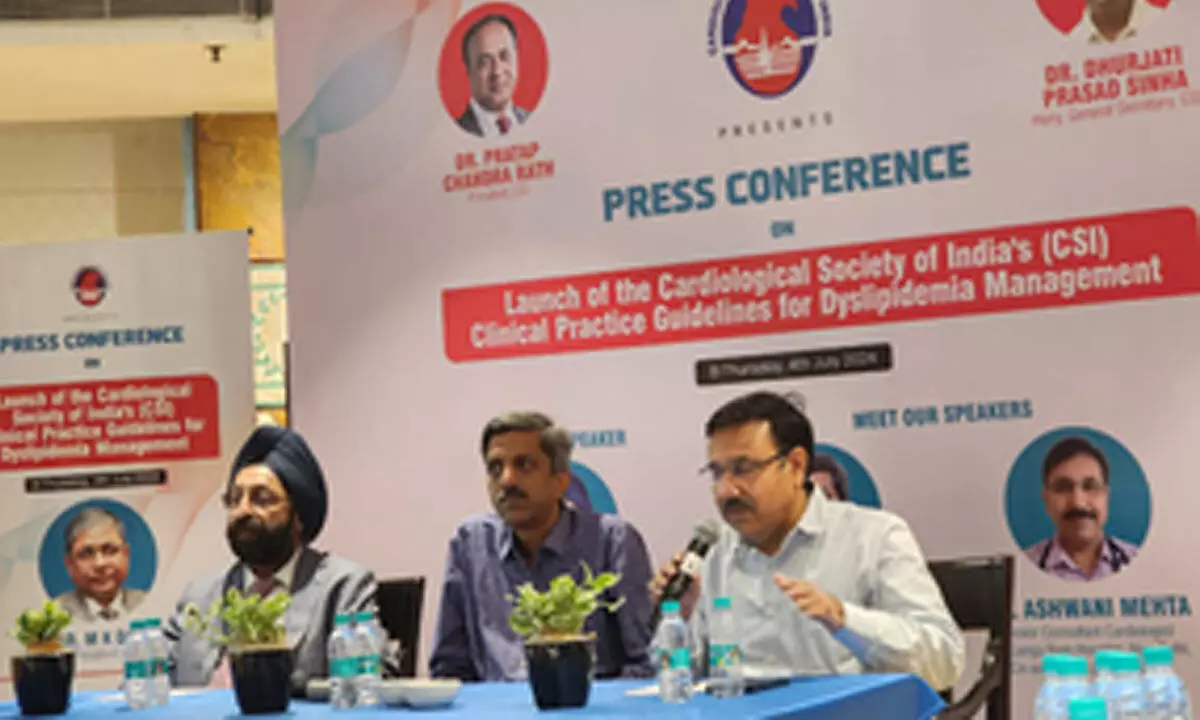Live
- BRS rallies support for Lagacharla ‘victims’
- COP29: Scientists, artists, faith leaders call for greater commitment to delivery of climate finance
- Woman donates liver to husband, saves life
- Mechanic Rocky Review: Thrilling Action Film with Twists and Great Performances
- Ponguleti Sudhakar Reddy rubbishes Rahul Gandhi's claims on Modi and Adani
- ‘We can’t take things for granted’: Jayasuriya on balancing formats and Sri Lanka’s path to WTC final
- Prakash Ambedkar ready to 'power' the winner in Maha polls - Mahayuti or MVA
- BJP plans campaign against Cong govt
- Be lifelines to public & render best, cops told
- Siri 2.0: Apple's Advanced AI Assistant to Be Released in 2026
Just In
Diabetes, BP patients must aim for bad cholesterol levels below 70 mg/dL: CSI

People in the general population or those with low-risk must maintain LDL (low-density lipoprotein) cholesterol, often called the “bad” cholesterol, levels below 100 mg/dL, while those with diabetes or hypertension should aim for LDL-C below 70 mg/dL, according to the first-ever Indian guidelines for dyslipidemia management released by the Cardiological Society of India (CSI) on Thursday.
New Delhi: People in the general population or those with low-risk must maintain LDL (low-density lipoprotein) cholesterol, often called the “bad” cholesterol, levels below 100 mg/dL, while those with diabetes or hypertension should aim for LDL-C below 70 mg/dL, according to the first-ever Indian guidelines for dyslipidemia management released by the Cardiological Society of India (CSI) on Thursday.
Dyslipidemia, characterised by high total cholesterol, elevated LDL-cholesterol, high triglycerides, and low HDL-cholesterol (good cholesterol), is a critical risk factor for cardiovascular diseases (CVD) such as heart attacks, strokes, and peripheral artery disease.
People in the very high-risk category, with extreme risk for CVDs, must aim for LDL-C levels below 55 mg/dL, noted the guidelines which come as the prevalence of dyslipidemia in India is getting alarmingly high, and the resulting CVDs are also surging, especially among the young adults.
New guidelines also recommend non-fasting lipid measurements for risk estimation and treatment, shifting from traditional fasting measurements. Increased LDL-C remains the primary target, but for patients with high triglycerides (more than 150 mg/dL), non-HDL cholesterol is the focus.
Non-HDL includes all the bad types of cholesterol.
“The general population and low-risk individuals should maintain LDL-C levels below 100 mg/dL and non-HDL-C levels below 130 mg/dL. High-risk individuals, such as those with diabetes or hypertension, should aim for LDL-C below 70 mg/dL and non-HDL below 100 mg/dL,” as per the guidelines.
"Aggressive targets are suggested for very high-risk patients, including those with a history of heart attacks, angina, stroke, or chronic kidney disease. These patients should aim for LDL-C levels below 55 mg/dL or non-HDL levels below 85 mg/dL," explained Dr. J. P. S. Sawhney, Chairman of the Department of Cardiology at Sir Ganga Ram Hospital, New Delhi, & Chairman of the Lipid Guidelines.
The guidelines stated that for patients with high triglycerides (more than 150 mg/dL) and non-HDL cholesterol is the target.
Furthermore, the guidelines recommend evaluating lipoprotein (a) levels at least once, as elevated levels (more than 50 mg/dL) are associated with cardiovascular disease. The prevalence of elevated lipoprotein (a) is higher in India (25 per cent) compared to the Western world (15-20 per cent).
It also called for lifestyle changes, such as regular exercise, quitting alcohol and tobacco, and reducing sugar and carbohydrate intake.
"High LDL-C and non-HDL-C can be controlled with a combination of statins and oral non-statin drugs. If goals are not achieved, injectable lipid-lowering drugs like PCSK9 inhibitors or Inclisiran are recommended," noted Dr. S. Ramakrishnan, Professor of Cardiology at AIIMS, New Delhi, & Co-Author of the Lipid Guidelines.
In patients with heart disease, stroke, or diabetes, statins, non-statin drugs, and fish oil (EPA) are recommended. Triglyceride levels above 500 mg/dL require the use of Fenofibrate, Saraglitazor, and Fish Oil, the experts said.

© 2024 Hyderabad Media House Limited/The Hans India. All rights reserved. Powered by hocalwire.com






